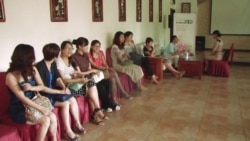An emotional advertisement about “leftover women” in China, which has gone viral, has uncovered not only the society’s deep-rooted discrimination against single women, but also the Chinese government’s inaction in tackling gender inequity issues, analysts say.
The four-minute-long document-style video, part of Japanese cosmetic giant SK-II’s global campaign to inspire women to change their destiny, has resonated with many unwed Chinese women over the age of 27 as it brings out their fear of being stigmatized as "sheng nu" or "leftover women".
In China, women are conventionally viewed as having an incomplete life if they remain unwed and are pressured into marrying in their 20s.
But on the social media site Weibo, there are more encouraging words than harsh criticism about "leftover women," after the video attracted tens of thousands of clicks in just a few days.
User Na Mi Zi commented, “They’re under so much pressure, from a mundane point of view. But really, it’s more important to just be yourself and happy.”
Selena Liu, an unmarried woman in Beijing, told VOA, "What everyone is looking for is different. For me, I am looking for true love. And if it means that I don't get married until I am in my late 30s or when I am 40, then that is ok."
Chinese writer Yuan Ren wrote about the topic in her column for The Telegraph newspaper.
“For me, it’s the vicious attack on single Chinese women that really smarts. If you look at the latest SK-II ad... close family is usually where the most hurtful jabs fire.”
SK-II said in a statement that it was adopting a positive approach in helping Chinese women overcome pressure.
And the final message it aims to spread is that Chinese women today are more educated than ever before and are increasingly resisting marriage if being single allows them to achieve more in life, according to Leta Hong Fincher, author of Leftover Women: The Resurgence of Gender Inequality in China, who played a consulting role in the video.
‘Grade A women vs. Grade D men’
With a population of 1.37 billion, China has more men than women, with the current ratio at 105:100. But prior to that, the decades-old one-child policy had seriously distorted the country’s gender balance.
According to Jiang Quanbao, a professor at Xi'an Jiaotong University's institute for population and development studies, Chinese men had outnumbered women by 36 million in the past three decades before 2010 as an estimated population of 20 million baby girls had likely been aborted.
So, in theory, China should have few worries about so-called "leftover women." On the contrary, "leftover men", also known as “bare branches,” should be a bigger concern, as it is estimated that at least 24 million Chinese men will be left with no local women to marry in 2020.
Jiang says what is at stake is women are traditionally on the lookout for partners with a higher social status. Now that Chinese women are more educated and financially independent, there are just not enough men with high status, she said.
So the challenge facing Chinese singles today boils down to the mismatch between Grade A women and Grade D men, said professor Jiang.
“The Grade A women vs. Grade D men phenomenon means that ‘leftover women’ usually have a higher social status, while most ‘leftover men’ are socially-disadvantaged with a lower socio-economic status,” Jiang said, adding that the rising cost of a wedding and keeping a wife is the major obstacle for "bare branches" seeking marriage, especially those in rural China.
There is no easy fix to the structural mismatch. But professor Jiang is optimistic that, as time progresses, liberal-minded parents will be eased with the individual choice of their unwed daughters.
Inside the box
But Zhang Jing, founder and executive director of Women's Rights in China, disagreed. She says the sensation with "leftover women" is a big fight against the Communist government’s hidden agenda to keep women inside the box of marriage.
“[Many of] the government’s policies have worsened society’s discrimination against women and gender inequity,” she said, referring to some state-owned firms’ hiring of men only and preferred layoffs of female employees.
Zhang also criticized Chinese President Xi Jinping for his lack of vision in addressing gender inequity after he openly encouraged Chinese women to put family harmony first while speaking to the All-China Women’s Federation in 2013.
Zhang is concerned that regardless of its economic development, China’s growing discrimination against "leftover women" may persist for a long time.
“China has now become so rich. Theoretically, this is the best time for the Chinese government to encourage, promote and liberate women,” she said, adding, “But the current economic prosperity has brought no benefits to women. Women are those who are laid off first and those who return home to their cooking chores,” she added.
Editor's note: One of the sources quoted in this story, Leta Hong Fincher, is a former VOA correspondent.










